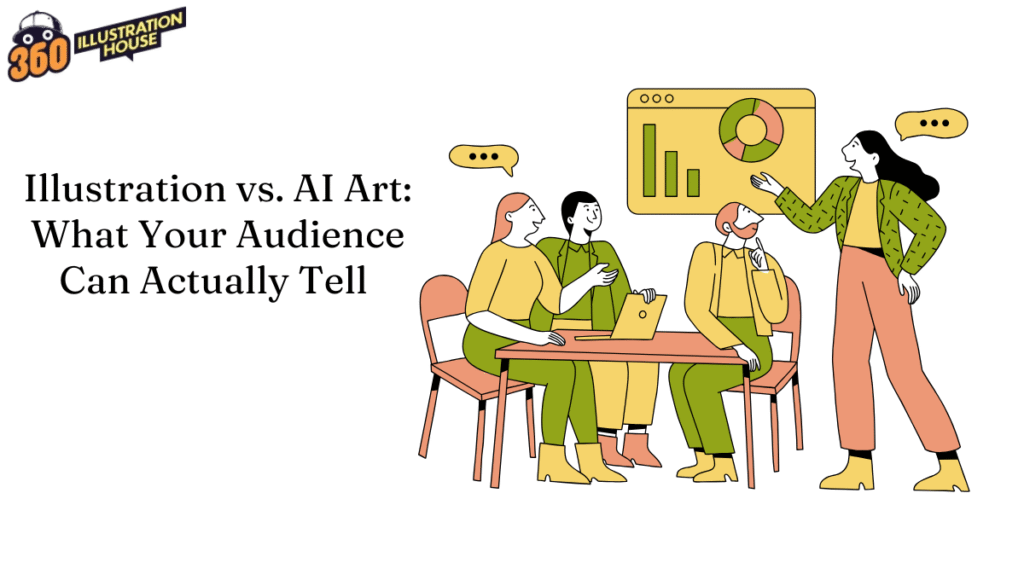
Do you remember when our social media feeds were flooded with “real or cake” videos? We had a great time guessing which one is a real thing and which one is an actual cake. Now the same thing applies to illustration vs AI art.
You will see so many posts, especially side-by-side comparisons of human illustrations vs AI. And much like the cake trend, the answer isn’t always easy to spot. The recent advancement in AI, such as MidJourney, DALL·E, and Stable Diffusion, has made it possible to generate polished, detailed images in seconds. They can mimic the look of watercolor paintings, digital sketches, or even hyper-detailed concept art.
Many of these AI creations can pass as professional illustrations — but once you look closer or for really long, you will start to see and spot differences. And that’s where the real question comes in: can your audience actually tell the difference, and why does it matter?
Let’s find out.
Illustration vs AI Art: What’s the Real Difference?
To accurately analyze illustration vs. AI art, it is first necessary to define both practices and understand their methodologies.
Illustration refers to artwork produced by humans, typically through manual or digital drawing tools. These works often reflect the creator’s unique perspective, emotions, and stylistic preferences.
Human illustrations are guided by:
- Interpretative storytelling
- Consistent artistic identity
- Purpose-driven visual design
Experts such as professional illustration design services commonly tailor their work to specific briefs. This ensures alignment with narrative objectives, emotional tone, and target audiences.
In contrast, AI art is produced by machine learning models trained on large datasets of existing images. Tools such as Midjourney, DALL·E, and Stable Diffusion enable users to generate artwork by inputting descriptive text prompts. The more detailed your prompt is, the better result you will receive.
These tools simulate creativity through statistical pattern recognition rather than conscious design.
While AI art excels in efficiency and stylistic mimicry, it often lacks the depth of human experience and the nuanced intent behind composition.
Can People Really Tell the Difference?
The answer depends on context, audience, and purpose.
-
Surface-Level Audiences
Casual viewers, for example, someone scrolling through Instagram, may not immediately spot AI art. Many AI tools produce polished images that mimic professional illustration styles.
Example: A fantasy book cover made with MidJourney may catch someone’s eye, and unless they’re trained in art, they won’t know it wasn’t drawn by hand.
-
Trained Eyes and Enthusiasts
Designers, illustrators, and art enthusiasts often notice patterns unique to AI, such as:
- Awkward hand shapes or anatomy.
- Overly smooth textures that lack brushstroke variation.
- Repeated visual motifs that feel “copied.”
-
The Emotional Test
Even if someone can’t explain why, they often feel something different.
Illustrations made by high-quality digital illustration services carry a sense of intentionality and personality. AI art feels flat. It is indeed beautiful, yes, but emotionally?? Very disconnected.
The Emotional Impact of Human-Created Art
A defining characteristic that separates illustration from AI art is emotional depth. Human illustrators are not just producing images; they communicate feelings, perspectives, and stories.
These illustrations often carry:
- Cultural References
- Emotional Tone
- Jokes
- Sense of Humor
- Purpose
- Message
- A Clear Sense of Voice and Intention
Audiences, even if subconsciously, pick up on these cues.
Art that shows real feelings, like joy, sadness, love, and humor, connects with us in a way that even the most advanced algorithms can’t match. On the other hand, AI-created art might look good at first glance, but when you look closer, it often seems hollow. It can feel like a perfect copy, technically correct but lacking emotional warmth.
Where AI Art Excels
It would be unfair to dismiss AI entirely. AI-generated art has its own set of advantages:
Speed: You can get multiple concepts in minutes. Based on your brief or manuscript, AI can generate storyboards that can help you illustrate your book even better.
Cost: For businesses on a budget, AI art might seem appealing compared to hiring a professional illustrator.
Exploration: AI can serve as a brainstorming partner, helping creators test different moods, styles, or compositions.
What Really Matters to Your Audience
Your audience may not always know how an image was made, but they care about the experience it creates.
Authenticity: People value art made with care and intention.
Trust: If you pass off AI work as handmade and get caught, audiences may feel misled.
Connection: Hand-drawn illustration creates stronger emotional ties.
Also, one more thing, a human psyche – we simply love nitpicking. So, when it comes to what the audience can actually tell? They pick up on visual glitches and mistakes, which immediately tells them which art is human and which one is AI.
The Ethical Debate
Audiences today are more informed than ever. They may not know the technical ins and outs of how AI is trained, but they can tell when something doesn’t feel fair or honest.
- They can tell when credit is missing. Viewers are quick to ask: Who made this? If a brand uses AI art without acknowledging it, or worse, passes it off as original illustration, audiences notice the lack of transparency.
- They can tell when work feels copied. Even if they don’t know the term “data scraping,” people pick up on recycled looks and patterns. They might say, “This style looks exactly like another artist’s work.” Which is, let’s be honest, true because AI trains on existing data of artists.
- They can tell when humans are being replaced. Many audiences care about supporting human creativity. They may not object to AI sketches, but they’ll speak out if it looks like an illustrator lost work to a machine.
Wrap Up
Your audience doesn’t have to be professional artists to understand what’s real. They can notice important signs like consistency, authenticity, emotion, cultural depth, and openness. These are not technical details; they are human signals that influence how much people trust you and feel connected to your work.
When it comes to illustration vs. AI art, YOUR choice should be less about what looks “better” and more about what your audience experiences.
AI may impress you and serve well for quick drafts, background visuals, or experimental marketing campaigns. But for projects that carry emotional weight, such as book covers, branding, or campaigns, you need human illustrations. The ones that can get you the audience’s trust and connection.
People don’t just see the art; they sense the human effort, creativity, and story behind it. And in a world where audiences are more aware, skeptical, and value-driven than ever, that difference is what makes your work stand out.
FAQs
Can AI art be used safely for commercial projects?
It depends on the project. For background visuals or brainstorming, it’s usually fine. For logos, book covers, or anything tied to intellectual property, copyright issues may arise.
Will audiences become better at spotting AI over time?
Yes. Just like people learned to notice Photoshop edits, they’re becoming sharper at spotting AI. The more AI art circulates, the more familiar its “fingerprints” become.
Is there any case where audiences prefer AI over illustration?
Sometimes. For fast-turnaround content like ads or social media experiments, many audiences don’t mind AI.
Does AI art affect copyright laws?
Yes. Since AI is trained on existing artwork, there are ongoing legal battles about who owns the rights to AI-generated pieces. If you plan to sell or publish AI art, always check current copyright guidelines.
Is it possible to collaborate with both AI and illustrators?
Absolutely. Many illustrators now use AI as a sketching tool. They generate base concepts and then refine them by hand. This offers them speed, and their art’s originality and consistency remain intact.
Are audiences more forgiving of AI in marketing vs. publishing?
Yes. For quick ads or digital content, audiences often don’t mind AI. But in books, branding, or personal art, people expect human creativity.



